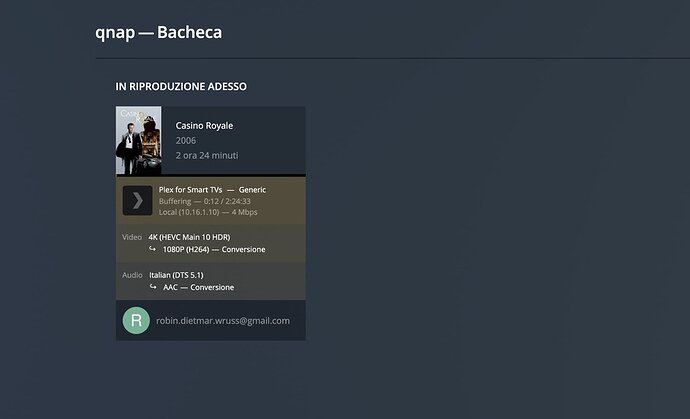I’m asking about this never ending discussion about 4K file formats (i.e: HEVC Main 10 HDR) played/streamed on QNAP Plex Media Server.
So far, I tried several different setup, but only a view of them works perfectly (mainly Apple Devices) without any issue, such as on-the-fly format converting, and/or without buffering.
Here what I’ve tested:
All tests have been executed on the same network, from the same subnets, with identical connection conditions, with the same bandwidth, and using the same network devices, as well player devices.
Plex Media Server: RPI 4 B Ubuntu 20.04 (x64), single 1 Gigabit NIC
- RPI CPU burned out after 4 concurrent direct streams
Plex Media Server: QNAP TS-453S Pro (RAM 8 Gb, SDD 32 TB, QTS 5.x), DUAL 1 Gigabit NIC (bond to 2 Gigabit) - QNAP NET burned out after 10 concurrent direct streams
Wired Network (LAN over 2 VLANs):
- Samsung Smart TV: NOT Working (video converting, buffering, 4 Mbps stream)
- Panasonic Viera TV: NOT Working (video converting, buffering, 4 Mbps stream)
- MacBook Pro macOS Monterey Chrome: NOT Working (video converting, audio converting, buffering, 56 Mbps stream) - recognized as REMOTE
- MacBook Pro macOS Monterey Safari: Working (video direct streaming, audio converting, no buffering, 40 Mbps stream) - recognized as LOCAL
- Apple TV 4K (64GB) Plex 7.26: Working (video direct streaming, audio direct streaming, no buffering, 40 Mbps stream) - recognized as LOCAL
- iPad Pro (256GB) Plex 7.26: Working (video direct streaming, audio direct streaming, no buffering, 40 Mbps stream) - recognized as LOCAL
- iPhone 12 Pro (256GB) Plex 7.26: Working (video direct streaming, audio direct streaming, no buffering, 40 Mbps stream) - recognized as LOCAL
Wireless Network (WiFi 2.4 Ghz & 5 Ghz over 3 VLANs):
- Samsung Smart TV: NOT Working (video converting, buffering, 4 Mbps stream)
- Panasonic Viera TV: NOT Working (video converting, buffering, 4 Mbps stream)
- MacBook Pro macOS Monterey Chrome: NOT Working (video converting, audio converting, buffering, 50 Mbps stream) - recognized as REMOTE
- MacBook Pro macOS Monterey Safari: Working (video direct streaming, audio converting, no buffering, 35 Mbps stream) - recognized as LOCAL
- Apple TV 4K (64GB) Plex 7.26: Working (video direct streaming, audio direct streaming, no buffering, 35 Mbps stream) - recognized as LOCAL
- iPad Pro (256GB) Plex 7.26: Working (video direct streaming, audio direct streaming, no buffering, 35 Mbps stream) - recognized as LOCAL
- iPhone 12 Pro (256GB) Plex 7.26: Working (video direct streaming, audio direct streaming, no buffering, 35 Mbps stream) - recognized as LOCAL
So, finally my tests highlights that the issue regarding 4K file formats on Plex, with all those conversion and buffering struggles, doesn’t hang on the Plex Server Platform type or version, but it highly depends on which player is used.
None of my Smart TVs, all high-end and very recently released models (QLED 4K & 8K TVs +/- up to 4,200 €), is able to stream 4K file formato, probably because devices or players are not correctly recognized by Plex Media Server, or maybe because Smart TV players don’t work/behave correctly.
Today, at my home setup, only Apple Devices behave perfectly to play/stream 4K file formats without any or only a very little impacting conversion activity (mainly on audio tracks).
Any idea how to solve this Smart TV issue playing/streaming 4K file formats?
Thanks.


